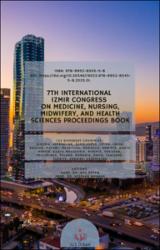Tramadolün Xenopus laevis embriyoları üzerindeki teratojenik etkilerinin kurbağa embriyo teratojenez testi (FETAX) yöntemiyle değerlendirilmesi

View/
Date
2025Author
Ün, BurçinBoğa Pekmezekmek, Ayper
Kalay, Betül
Akarsakarya, Zeki
Yorulmaz Özü, Özlem
Ilgaz, Nermin Seda
Erdoğan, Şeyda
Seçilmiş, Mehmet Ata
Metadata
Show full item recordCitation
Ün B., Boğa Pekmezekmek A., Kalay B., Akarsakarya Z., Yorulmaz Özü Ö., Ilgaz NS., Erdoğan Ş, Seçilmiş MA. Tramadolün Xenopus laevis embriyoları üzerindeki teratojenik etkilerinin kurbağa embriyo teratojenez testi (FETAX) yöntemiyle değerlendirilmesi. 7. Uluslararası İzmir Tıp Hemşirelik Ebelik ve Sağlık Bilimleri Kongresi, 2025.Abstract
Tramadol, merkezi sinir sistemi üzerinde etkili bir opioid analjezik olup gebelikte ağrı yönetiminde kullanılmaktadır. Ancak, tramadolün gebelikteki güvenliği ve potansiyel teratojenik etkileri hakkında sınırlı bilgi mevcuttur. Bu çalışmada, tramadolün teratojenik potansiyeli, Xenopus laevis embriyolarında FETAX (Frog Embryo Teratogenesis Assay: Xenopus) yöntemiyle değerlendirilmiştir.
Araştırmada, 15 yetişkin Xenopus laevis kurbağasından in vitro fertilizasyon (IVF) yöntemiyle embriyolar elde edilmiştir. Bu embriyolar, farklı tramadol konsantrasyonlarına (0.001, 0.01, 0.1, 0.5, 1, 5, 10 μg/mL) 96 saat süreyle maruz bırakılmıştır. Her 24 saatte bir gelişim evreleri mikroskop altında incelenmiş, normal, anormal ve ölüm oranları kaydedilmiş ve solüsyonlar yenilenmiştir. Deney sonunda embriyolar histopatolojik olarak analiz edilmiş ve bu bulgular teratojenik etkilerin değerlendirilmesinde kullanılmıştır. Ayrıca, erken gelişim döneminde önemli rol oynayan Esr1, Pax6, Bmp4, Myf5 ve Hsp70 genlerinin ekspresyon seviyeleri gerçek zamanlı polimeraz zincir reaksiyonu (RT-PCR) ile ölçülmüştür.
Sonuçlar, tramadol konsantrasyonlarındaki artışın embriyolarda büyüme geriliği ve teratojenite oranında anlamlı artışlara yol açtığını göstermiştir (p<0.05). Histopatolojik incelemelerde ödem, mikroftalmi ve kuyruk deformasyonu gibi çeşitli konjenital malformasyonlar tespit edilmiştir. Bununla birlikte, Esr1, Pax6, Bmp4, Myf5 ve Hsp70 gen ekspresyon seviyelerinde değişiklikler gözlenmiş olsa da, bu değişiklikler istatistiksel olarak anlamlı bulunmamıştır (p>0.05).
Bu çalışma, tramadolün yüksek konsantrasyonlarda Xenopus laevis embriyoları üzerinde epigenetik etkiler oluşturabileceği ve bu sebeple ilacın gebelikte kullanımında dikkatli olunması gerektiği sonucuna varılmıştır. Tramadol is used for pain management in pregnancy as it is an opioid analgesic that affects the central nervous system. However, there is limited information on the safety and potential teratogenic effects of tramadol in pregnancy. In this study, the teratogenic potential of tramadol was evaluated in Xenopus laevis embryos using the FETAX (Frog Embryo Teratogenesis Assay: Xenopus) method.
In this study, embryos were obtained from 15 adult Xenopus laevis frogs by in vitro fertilization (IVF) method. These embryos were exposed to different concentrations of tramadol (0.001, 0.01, 0.1, 0.5, 1, 5, 10 μg/mL) for 96 hours. Every 24 hours, the developmental stages were examined under a microscope, normal, abnormal and death rates were recorded and the solutions were replaced. After the experiment, embryos were analyzed histopathologically and these findings were used to evaluate teratogenic effects. In addition, expression levels of Esr1, Pax6, Bmp4, Myf5 and Hsp70 genes, which play an important role in early development, were measured by real-time polymerase chain reaction (RT-PCR).
The results showed that increasing tramadol concentrations caused significant increases in the rate of growth retardation and teratogenicity in embryos (p<0.05). Histopathological examinations revealed various congenital malformations such as edema, microphthalmia and tail deformation. However, although changes in Esr1, Pax6, Bmp4, Myf5 and Hsp70 gene expression levels were observed, these changes were not statistically significant (p>0.05).
This study concludes that tramadol at high concentrations may cause epigenetic effects on Xenopus laevis embryos and therefore caution should be exercised when using the drug during pregnancy.

















